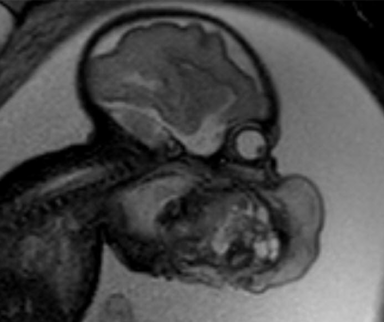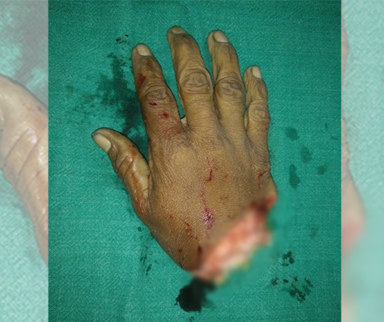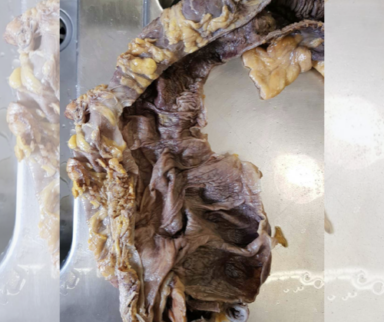Patients receive the best care in the emergency room between 6 a.m. and noon, according to an exclusive poll of healthcare professionals around the world. The survey was conducted between Oct. 19 and Oct. 21 on Figure 1, a case-sharing platform used by more than 500,000 physicians, nurses, paramedics, and medical students in 173 countries.
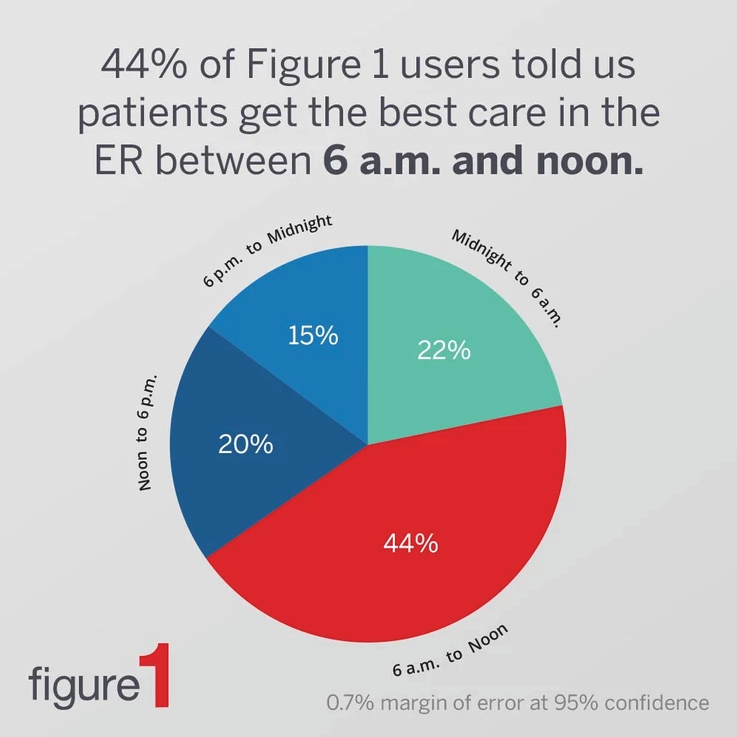
The Figure 1 community was asked when, in their opinion, patients receive the best care in the emergency room. They had four multiple-choice options — between midnight and 6 a.m., 6 a.m. to noon, noon to 6 p.m., and 6 p.m. to midnight — and were invited to explain their answers in the comments. We received 17,428 responses and 399 comments in the 48-hour survey period. Figure 1 users in 115 countries took part, with the majority coming from the United States, Great Britain, Canada, Australia, the Netherlands, and Brazil.
It was clear that emergency room wait times are a hot-button issue the world over. There’s the obvious concern: Can you get urgent care when you need it? And then there’s the fact that the ER is literally and figuratively the pain point of the healthcare system. If the primary care network is functioning — public health awareness, family physicians, telehealth lines, and walk-in clinics — the ER can focus on emergencies. But when the system fails, the problems appear first in the emergency room. All of which is of little concern when you’re in excruciating pain and just want the best care as soon as possible. What do you need to know at that moment?
Here are Nine Key Findings From Our Survey
1. More Healthcare Professionals Recommended the Mid-Morning Than Any Other Time
The 6 a.m. to noon timeslot was chosen by 44% of respondents. There were two main explanations offered. First, the hospital staff is functioning at peak efficiency in the early morning. “Coffee is fresh and all hospital functions are open,” wrote one family physician. (“Fresh coffee is the key to an efficient emergency department,” agreed a technologist and a registered nurse noted that the “best thing our managers ever invested in was a Keurig for us.”) As one psychiatrist pointed out, there’s a particular sort of extra planning that goes into morning care:
I find the night staff go over their plans before handing over to morning staff, not wanting to look silly, etc. Then the morning staff, usually fresh, assume the night staff were tired and go over the plan again, just to be sure. — Psychiatrist
The other reason cited was the caseload. By mid-morning, medical clinics and doctor’s offices are generally open, relieving some of the strain.
In my workplace in the Philippines, 6 a.m. to noon [is when] most of the doctors are present. Attending physicians and consultants are available. Patients during this time have the best management. — Registered Nurse
Our ED picks up around 10 a.m. and lulls around 1 a.m., but not all services are open. Services start rounding at 7 a.m., so your best care would be when the ED is not busy, but is fully staffed — 6-10 a.m., really. — Registered Nurse
Between the hours of 6 and noon you have fresh practitioners and usually a higher level of administration present in the building, which helps with patient flow on a lot of levels. — Registered Nurse
The best time to go to our ER (the biggest in Holland) would be between 8 and 10 a.m. It’s mostly the quietest time and the staff has just started their work hours. I would rate 5 to 7 a.m. as the most dangerous, as the most serious cases (cardiac asthma, myocardial infarction, traffic trauma) tend to present themselves in those hours and everyone is tired. — Anesthesiologist
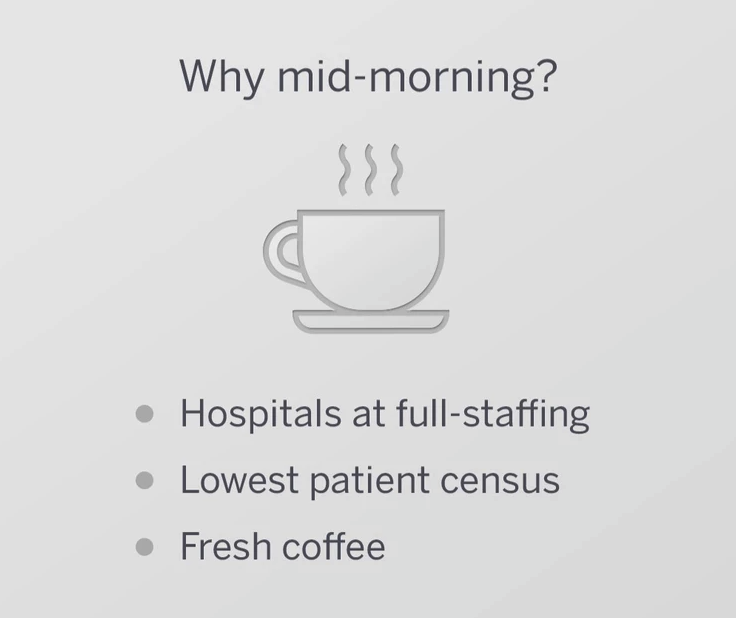
2. Emergency Room Professionals Had a Similar Preference
Healthcare professionals who identified their specialties as emergency medicine or paramedic were in close agreement with the findings of the survey. Of the 1,425 ER specialists who responded, 658 (46%) recommended the 6 a.m. to noon slot with a 2.6% margin of error at 95% confidence.
As a nurse in an urban ER, I know that quality care for the stable patient is impacted by numbers. From 6am-12 patient load is the smallest, everything happens faster. Hard to deliver the best care with 45 in the waiting room & no beds. — Registered Nurse
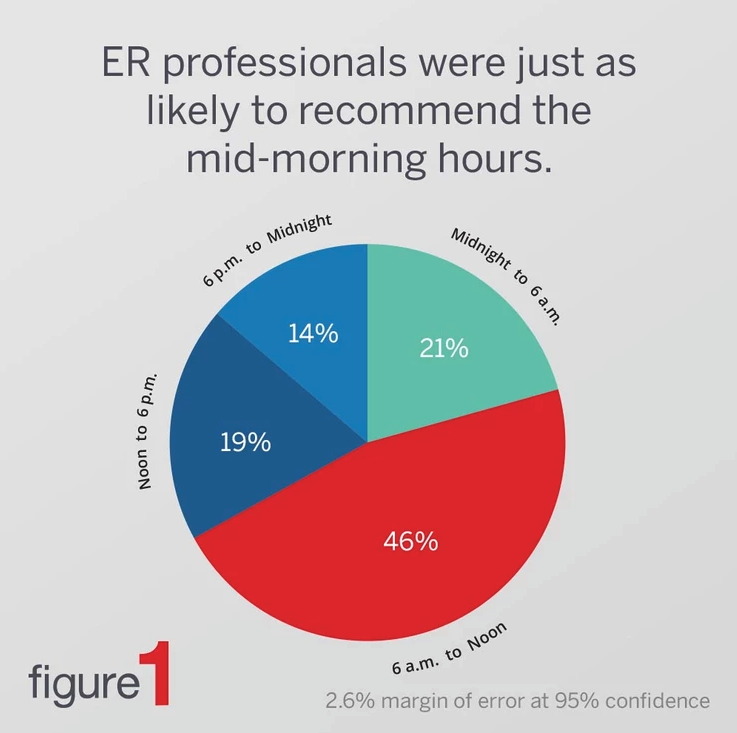
3. The Early Mornings Are a Distant Second
Though the availability of specialized treatment may vary between midnight and 6 a.m., in some cases healthcare professionals said the reduced caseload made for better care at this time.
Our ER is usually least busy from 12-6 a.m., and it shows. Patients get much more thorough care and the staff actually know what’s going on. During the day, when the ED (emergency department) census is pages long, they seem to get very little done for each patient and can’t chart or tell us much of anything. — Registered Nurse
I’ve worked all shifts in a level 1 trauma center ER. After midnight you’ll often be seen faster and only if you need MRI or nuclear medicine will there be a delay. — Technician
4. Evenings Are To Be Avoided
Only 15% of respondents chose the 6 p.m. to midnight slot (0.5% margin of error at 95% confidence). The explanation was consistent with the preference for morning care: All the departments that were up-and-running during the workday are now at reduced capacity, while the number of incoming patients is likely peaking.
[T]he day steadily builds with the peak times around 7-9 at night as all primary care and urgent care centers are closed, so the evening is the worst time to come due to wait times only. — Nurse Practitioner
5. Though All Countries Recommended the Mid-Morning, There Were Regional Variations
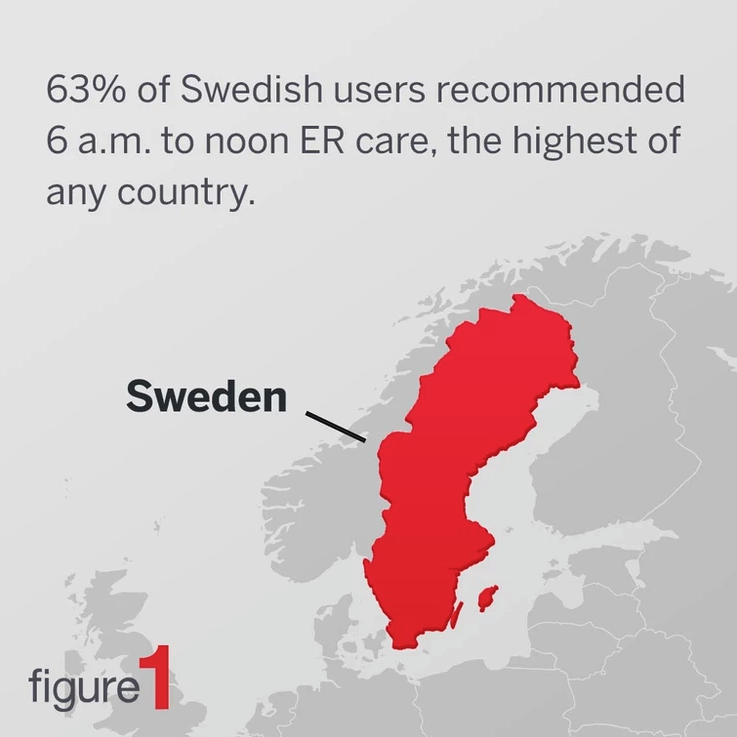
63% of Swedish respondents chose the 6 a.m. to noon slot, the highest preference of any country (10.7% margin of error at 95% confidence). In Pakistan, there was no statistical difference between preferences for 6 a.m. to midnight — but a strong vote for midnight to 6 a.m. as the worst time to visit the ER. Only 11% of Pakistani users chose this time, with a 5.8% margin of error at 95% confidence.
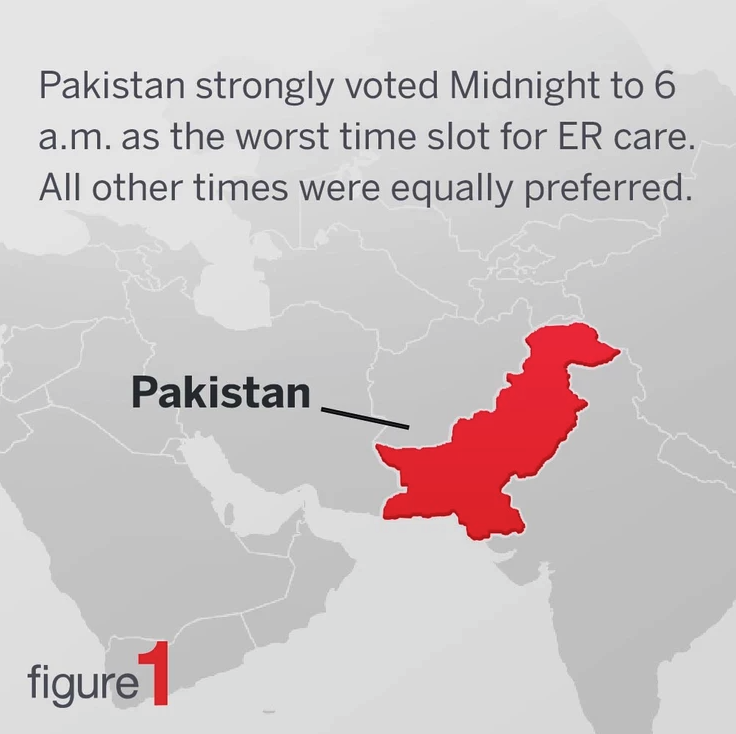
6. Even Suggesting Care Would Ever Be Sub-Optimal Was Controversial
All the time. Emergency is emergency. – Cardiologist
All times the best care is given. Time problems are a result of people coming to the ER for less serious issues. — Registered Nurse
I’m with all the 6 a.m.-12 p.m. folks. It’s nice to say that patients get the best care “24-7”, but denying the human limitations of clinicians doesn’t get us anywhere. Unfortunately, when the ER is busy, your care isn’t as likely to be thoughtful and thorough — not malice on anybody’s part, but because one only has so much attention and resources to give. — Paramedic
7. The Complexity of the Question Raises Some of the Biggest Issues in Modern Healthcare
I think the last numbers I read showed that somewhere around 70% of ED visits were for non-emergent conditions. Plus, ED visits are crazy high. I worry about enslaving the uninsured population with an ER bill that they will most likely never pay off! And, hospitals report the bad debt to the credit reporting agencies. The ramifications of empirically treating everything is much larger. – Nurse Practitioner
I personally don’t think there is an ideal time to go to the ER. It is not used for “true emergencies” anymore. It’s your PCP (primary care provider), your therapist, your only hot meal, your dialysis clinic, your child’s pediatrician, etc. The face of the ER has drastically changed. — Registered Nurse
The state of our health care is sad. We need to act. Resources are misappropriated. We just need to rethink the way we deliver care. — Medical Student
8. These Findings Are Generally Consistent With Formal Studies on ER Care
Most studies examining emergency room wait times define a successful visit as one during which you don’t die. Which is certainly true, but perhaps lacking in detail. These studies have repeatedly found no correlation between mortality and time of admittance — which confirms the respondents who said the best care is always given. Of course, there are many factors that are not life-or-death but still worth knowing. For instance, a 2008 analysis of 62,814 patients who presented with acute myocardial infarction (heart attacks) in the U.S. found no significant difference in mortality associated with when they arrived in the ER. However, wait times for those patients were 25 minutes longer if they arrived during the night (7 p.m. to 7 a.m.).
9. It Never Hurts To Be Polite
People receive the best ER care when they are willing to take part in their treatment and work with the health care professionals. — Registered Nurse
I should hope that no matter what the situation is they will always get the best care but you will be treated better if you are polite and patient and understand triage. I always hope a patient understands that if you have been in the ER waiting for 4 hours with a sprained finger or a bloody nose and someone comes in having a MI (myocardial infarction, or heart attack) .. they are obviously going to be seen first. — Nursing student
Published June 2021
Join the Conversation
Register for Figure 1 and be part of a global community of healthcare professionals gaining medical knowledge, securely sharing real patient cases, and improving outcomes.
